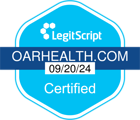How To Cut Back On Drinking: 6 Proven Tools

In This Article
- 1. Set a Clear, Attainable Goal
- 2. Remove Alcohol From Your Living Space
- 3. Find (Or Create) An Accountability Group
- 4. Track Your Drinking
- 5. Adopt a Fitness Routine for Structure and a Healthy Reward System
- 6. Consider Naltrexone for Additional Support
- Final Thoughts: Building Your Alcohol-Free Tool belt
1. Set a Clear, Attainable Goal
If you're here, you might be asking, "How can I drink less alcohol?" Whether you’re looking to cut back or completely remove alcohol from your life, having a strong, practical toolkit can make all the difference.
Below, we’ve compiled six powerful strategies for anyone ready to take control of their drinking habits. This ultimate alcohol-free tool belt is rooted in methods that work, giving you a solid foundation to succeed.
Aiming to reduce or quit drinking starts with a goal. Decide what you want to achieve and why—whether it’s for better health, improved relationships, or greater mental clarity. Keep your goal attainable, especially at first. Set measurable benchmarks, like “I’ll drink only on weekends” or “I’ll reduce to two drinks per night.” When your goals are realistic, you're more likely to succeed.
How to Set Goals that Stick
- Be specific: Write down your goal and the exact changes you want to see
- Make it measurable: Use numbers and deadlines, like reducing to one drink per night by the end of the month
- Stay motivated: Revisit your goals regularly and remind yourself why they matter
2. Remove Alcohol From Your Living Space
A common reason people slip back into old drinking habits is the availability of alcohol at home. If alcohol is easily accessible, it’s tempting to reach for it during stress or boredom. Removing it from your environment is a straightforward but highly effective way to curb compulsive drinking behavior. It’s easier to stick to your goal if alcohol isn’t just a step away.
Practical Tips for Removing Alcohol
- Clear out your alcohol supply or at least reduce the quantity
- Replace it with healthier alternatives, like sparkling water or non-alcoholic drinks
- Enlist the support of family members or roommates if you share a living space
3. Find (Or Create) An Accountability Group
Accountability is a game-changer for making lasting changes. Joining or forming a support group not only connects you with people on a similar journey but also creates a layer of responsibility. Sharing your goal with others keeps you on track and gives you a support system during moments of weakness. Many online communities, from fitness groups to sober communities, offer this accountability.
Steps to Create Accountability
- Find a local support group or online community that aligns with your goals
- Share your intention to drink less with the group
- Check-in regularly to report your progress and stay motivated
4. Track Your Drinking
Tracking your alcohol intake helps create awareness around your drinking habits. For many, seeing patterns of when and why they drink can lead to breakthroughs. There are plenty of ways to track—some prefer old-school methods like marking days on a calendar, while others use cost-effective apps that provide valuable insights.
Tips for Effective Tracking
- Use a calendar and mark the days you drink or stay alcohol-free
- Try apps like Sunnyside or Cutback Coach that track your drinking and give you helpful feedback
- Review your tracking log weekly to monitor your progress and identify patterns
5. Adopt a Fitness Routine for Structure and a Healthy Reward System
Regular exercise provides structure, releases endorphins, and creates a sense of accomplishment—all of which can help reduce the urge to drink. A fitness routine offers a positive outlet for stress and acts as a healthy replacement for alcohol. Plus, building physical strength often fuels mental resilience, making it easier to resist temptations.
Starting a Fitness Routine
- Set fitness goals that complement your drinking reduction goals
- Try different types of exercise, from cardio and weight training to yoga and mindfulness activities
- Use fitness apps or join a local gym to stay motivated and track your progress
6. Consider Naltrexone for Additional Support
For those needing extra support, medication like Naltrexone can be a valuable tool. Naltrexone is an FDA-approved medication that can reduce alcohol cravings by blocking the euphoric effects of alcohol. This option may not be for everyone, so consulting with a healthcare professional is essential to decide if it’s right for you.
Understanding Naltrexone
- Talk to your doctor about the pros and cons of using naltrexone
- Use naltrexone in conjunction with other strategies for the best results
- Monitor any side effects and stay consistent with your medication regimen
Final Thoughts: Building Your Alcohol-Free Tool belt
Cutting back or quitting drinking isn’t easy, but with the right tools in your arsenal, it’s more than achievable. This alcohol-free tool belt combines actionable goals, a supportive environment, community accountability, self-awareness, a fitness routine, and optional medical support for a holistic approach to reducing alcohol consumption.
Take it one step at a time, surround yourself with a supportive community, and lean into the power of fitness to fuel your path to freedom.
Are You Drinking Too Much?
Is drinking affecting your job? Is alcohol harming your health or relationships? Does your drinking worry you? Ever tried to drink less but failed?
If any of this sounds familiar, Oar Health might be right for you. Oar Health offers medication FDA-approved for the treatment of alcohol problems. A daily pill to drink less or quit.
About The Author
Jesse is the founder of Altum Fitness and host of the Sober Strength podcast. He is a USMC veteran, certified fitness trainer and health coach, and former healthcare executive. Jesse started Altum Fitness in 2023 with the mission to help people discover and maintain healthy habits to live deep, strong, meaningful lives. Jesse resides in Colorado with his wife, Meghan, and their three beautiful children.





